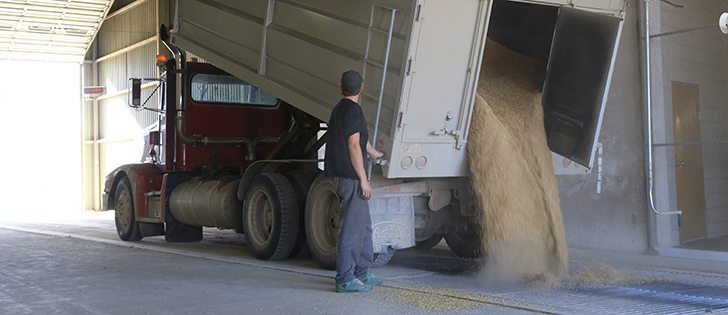Big crop, busy elevators | Growers may have a hard time selling uncontracted grain
With elevators plugged, bearish fundamentals clouding the winter outlook and piles of crop lying in the field, farmers have a challenging marketing season ahead.
It’s one in which it’s hard to know what to sell first, what to price and what to hold on to. It’s especially hard this autumn because many elevators are full for weeks to come, so clearing crop for space and then having masses of crop to sell later will be the fate of many farmers.
“Once we get through all this harvest pressure, hopefully it will get better,” said Kindersley, Sask., farmer Morgan Nunweiler, chair of the Saskatchewan Pulse Growers Association, as he helped a neigh-bour harvest his crops on a warm October day.
Read Also

India slaps 30 per cent import duty on yellow peas
India has imposed a 30 per cent duty on yellow pea imports with a bill of lading date on or after Nov. 1, 2025.
“For farmers who have piles of grain on the ground, it’s a pretty time-sensitive matter to get those piles moved.”
Farmers are grappling with a bumper crop that has stressful side effects.
So many farmers have bigger than expected crops that they have too little priced and haven’t arranged delivery for the proportion of their crop that they would normally have booked.
Finding elevators that will take uncontracted grain now is impossible in many areas, a vexing concern for any farmer who has run out of storage space and needs to move the crop now before weather and pests start damaging its quality.
It’s also an annoyance for farmers with enough storage space, but who need to sell lots of crop in coming months and now face bad basis levels and a declining futures market.
Farm marketing adviser Brenda Tjaden Lepp said farmers face few good prospects for wheat and oilseed prices, so she has recommended her clients price most of those crops. A big corn crop in the United States is going to restrain the ability of any cereal grain to rally this winter, so there isn’t much reason to hold on hoping for a rally.
Oilseeds are also well supplied, especially canola, but at least there is steady demand that will sweep up the crop. Therefore, even if prices don’t look good over the winter, canola will probably be easier to move later in the winter than wheat.
However, some special crops actually have bullish fundamentals, so Tjaden Lepp is recommending farmers price less of those crops in the hopes of a late winter to spring rally.
“For some (special crops) there’s a better chance of the supply-demand balance changing or coming through this (generally) glutted year better,” said Tjaden Lepp.
Edible beans have low supplies and could rally late in the winter, rye has a bullish outlook and even well-supplied peas and lentils could rise if late-season buying comes into the market.
“If that happens this year, we won’t have disgustingly overburdened stocks,” said Tjaden Lepp.
John DePape of Farmers Advanced Risk Management Company, which specializes in sales timing based on storage premiums and carrying costs, said farmers face a trickier than usual situation this year because of the need to book deliveries in a congested system.
They must balance their need to guarantee they can move crop when they need the cash flow with their outlook on possible basis improvements during winter. Often basis levels improve in winter, but it can be perilous to wait in a year of congestion like this.
“You might be better off looking at January, February, March and locking in your basis now just to make sure you’re in the queue,” said DePape.
“What’s 10 cents (of possible improvement) if you can’t deliver?”
Positive carry between futures months takes some of the pain out of having to carry big supplies into the mid-winter, DePape said, with farmers now being paid to store their grain.
Last year many markets were inverted, rewarding farmers for immediate delivery and penalizing those who held on to crop.
“The spreads pay you to store,” said DePape.
Overhanging all marketing decisions for farmers this year will be the worry about the system getting further congested if something goes wrong.
“If there’s any glitch at all, grain backs up,” said DePape.
Tjaden Lepp thinks prices for wheat and canola look vulnerable to further declines, especially with big U.S. cereal and oilseed crops coming in, so those winter and spring premiums in the futures market shouldn’t be ignored.
“Those premiums aren’t going to last, given the supply forecast for some of these crops,” said Tjaden Lepp.
















